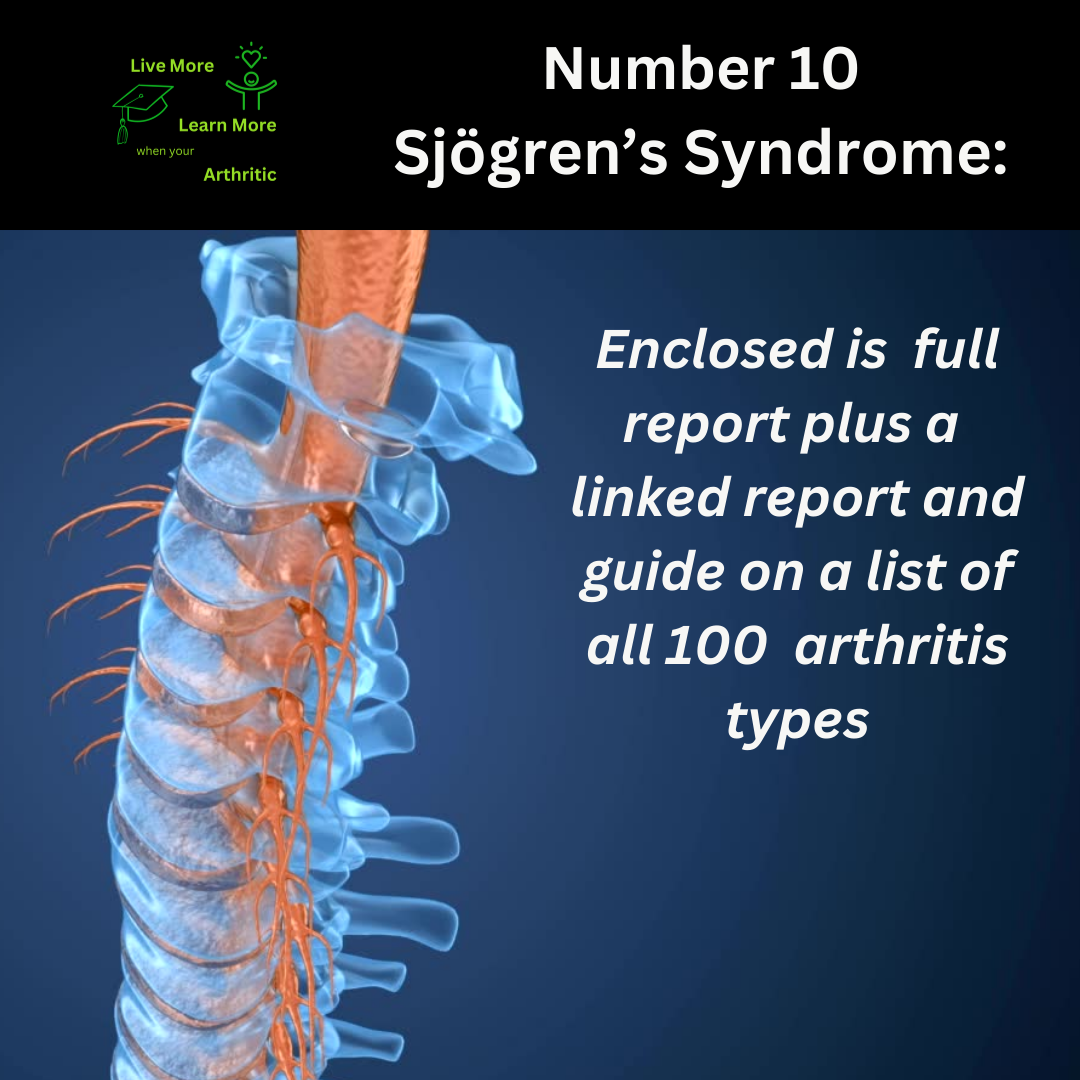
Sjögren’s Syndrome: Number 10 on the list of 100 types of Arthritis
Navigating Life with Sjögren’s Syndrome: A Personal Journey of Strength and Resilience
Imagine waking up each day with a dryness that permeates your entire being—your eyes scratchy and irritated, your mouth parched and unable to produce saliva. This is the reality for those living with Sjögren’s Syndrome, a complex autoimmune condition that affects millions worldwide. While the journey may be challenging, there is hope and resilience in understanding and managing this condition with a proactive approach.
 Description of Sjögren’s Syndrome
Description of Sjögren’s Syndrome
Sjögren’s Syndrome is an autoimmune disorder in which the body’s immune system mistakenly attacks its own moisture-producing glands, primarily targeting the salivary and lacrimal (tear) glands. This attack results in dryness of the eyes and mouth, known as sicca symptoms. In addition to dryness, Sjögren’s Syndrome can also affect other parts of the body, leading to joint pain, fatigue, and various systemic manifestations.
Causes and Triggers
The exact cause of Sjögren’s Syndrome remains unclear, but it is believed to involve a combination of genetic predisposition and environmental triggers. Certain factors, such as viral infections or hormonal changes, may contribute to the development of this autoimmune response.
Symptoms and Impact on Quality of Life
Aside from dryness, individuals with Sjögren’s Syndrome may experience a range of symptoms including joint pain and swelling, muscle fatigue, and difficulty swallowing. Limited range of motion in the joints can occur due to inflammation and stiffness, impacting mobility and daily activities.
Age of Onset and Impact on Lifespan
Sjögren’s Syndrome can affect individuals of any age, but it is most commonly diagnosed in people between the ages of 40 and 60. While this condition is chronic and lifelong, it typically does not shorten one’s lifespan. However, managing symptoms and potential complications is crucial for maintaining overall health and well-being.
Achieving a Higher Quality of Life
With a proactive approach, individuals with Sjögren’s Syndrome can enhance their quality of life and manage symptoms effectively. Strategies include:
- Hydration: Drinking plenty of water and using artificial tears or saliva substitutes to alleviate dryness.
- Moisturizing: Regularly applying moisturizing creams or lotions to the skin to prevent dryness and irritation.
- Joint Care: Gentle exercise, such as yoga or swimming, can help maintain joint flexibility and reduce stiffness.
- Dietary Modifications: Consuming foods rich in omega-3 fatty acids and antioxidants may help reduce inflammation and support overall health.
Possible Complications
Sjögren’s Syndrome can lead to complications affecting various organs, including:
- Dental Issues: Dry mouth increases the risk of dental decay and gum disease.
- Eye Problems: Severe dryness can damage the cornea and increase the risk of infections.
- Systemic Involvement: In some cases, Sjögren’s Syndrome may affect organs such as the lungs, kidneys, or nervous system.
 Holistic and Natural Approaches
Holistic and Natural Approaches
While there’s no cure for Sjögren’s Syndrome, some individuals find relief from symptoms through holistic approaches such as:
- Herbal Remedies: Certain herbs like chamomile or licorice root may have soothing effects on dryness.
- Acupuncture: This traditional Chinese therapy may help alleviate pain and improve overall well-being.
Prevalence and Gender Distribution
Sjögren’s Syndrome predominantly affects women, with a female-to-male ratio of about 9:1. While it can occur at any age, it is most commonly diagnosed during middle adulthood.
In conclusion, living with Sjögren’s Syndrome requires resilience, adaptability, and a proactive approach to managing symptoms. By embracing lifestyle modifications, seeking appropriate medical care, and exploring holistic strategies, individuals with Sjögren’s Syndrome can navigate their journey with hope and optimism. Each day becomes an opportunity to discover new ways of thriving despite the challenges posed by this autoimmune condition, fostering a sense of empowerment and strength in the face of adversity.